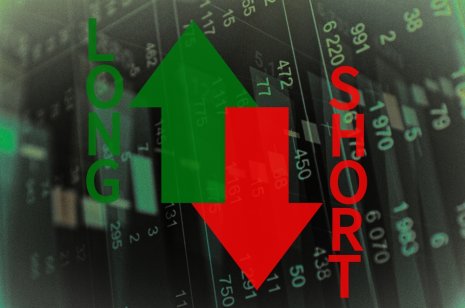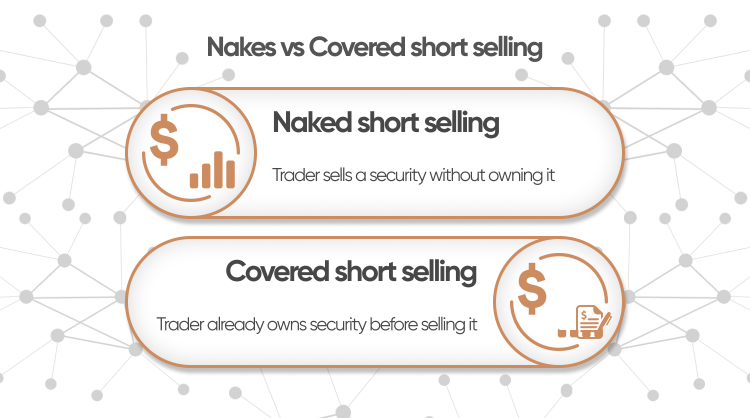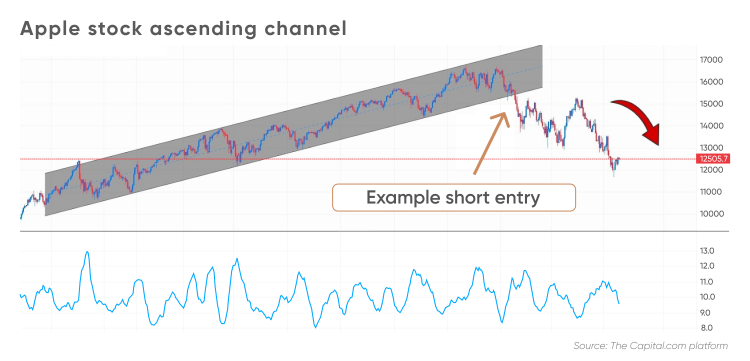Short selling in trading and investing: Everything you need to know

Short selling turns conventional investing on its head as it’s based on hopes that the price of an asset will fall.
What does it mean to short a stock? How does this trading strategy work, and what risks does it carry? Read on to learn more.
What is short selling?
Short selling, also known as going short or making a short sale, is a technique used by traders and investors to try to profit from falling asset prices.
An investor buys a security in the hope of selling it at a higher price. This is known as a long position. When short selling, the process starts the other way around. An investor sells first, then buys. This is known as a short position.
For example, an investor may have decided that the price of a certain stock may soon decline. A traditional long-only investor would simply not buy that stock and look for other areas to invest. A short-seller would opt to sell that stock to try to benefit from the expected price decline. Note that markets are volatile and the price may go in the opposite direction.
But, how can you sell an asset you don't own? You borrow it from a broker - for a fee - and then sell it. When the share price reaches a level you are happy with, you buy it back and return the asset to its original owner.
The difference between the purchase price and the sale price is your profit (or loss if things haven't gone to plan). You will also pay a fee to the broker who lent you the asset.
Short selling doesn’t just happen in the stock market. Selling short is particularly common in the futures market, as every futures contract involves a buyer (long) and a seller (short).
How does short selling work in CFDs?
Short selling has been made especially accessible to retail traders through the use of contracts for difference (CFDs). A CFD is a type of derivative instrument that allows two parties to speculate on the price movement of an underlying asset without actually owning the asset. Shorting a stock through CFDs avoids having to borrow shares from a broker for a fee.
When short selling in CFDs, traders are essentially anticipating that the price of the underlying asset will fall. If the price does indeed fall, the trader will make a profit, equal to the difference between the strike price and the current market price. However, if the price of the underlying asset rises, the trader will incur a loss. Short selling in CFDs is a risky strategy, but the use of risk management tools can help to make it effective.
Remember that CFDs are complex instruments. Trading them entails a high degree of risk as CFDs often use leverage. The value of a trade can rise and fall. You may suffer losses if the market moves against you. CFD risk management is a crucial factor to consider and implement when trading.
Naked vs Covered short selling
There are two main types of short selling: naked short selling and covered short selling. In naked short selling, the trader sells a security without owning it, for example by trading CFDs. This is a risky strategy – the trader is exposed to unlimited losses if the price of the security goes up.
Covered short selling is a relatively safer strategy – the trader owns the security before selling it. This means that the trader's losses are limited to the price of the security at the time of purchase.

Short selling example
One of the latest examples of short selling is Michael Burry’s bet against Apple (AAPL) revealed on 17 May. According to the SEC filing for the first quarter, Burry, ‘The Big Short’ investor known for predicting the housing bubble of 2008, had a $36m short position against the tech giant.
Burry did this through the options market, using put options against 206,000 Apple shares. This is an alternative way to trade against a share price versus going short on the actual shares.

With the benefit of hindsight, it can be seen that short trading Apple would have been beneficial when the Apple stock price exited the ascending channel pattern. The breakdown from the channel pattern explained a possible end of the bull market and potential for the Apple share price to enter a correction or even a bear market.
We can also see that had a trade tried to short apple stock when the price was within the rising channel, the trade might not have worked because the share price kept rising.
Note that your decision to trade should depend on your risk tolerance, portfolio size and goals, and your experience in the markets. You should always conduct your own due diligence before trading, looking at fundamental and technical analysis. Remember that markets are volatile and past performance does not guarantee future returns.
Short selling as a hedge
Using short selling for hedging is a popular investment strategy. The motivation for hedging is different to that of speculation, though the act of selling short is the same.
The hedger is aiming to minimize potential short-term losses when an asset they own is likely to go down in price. For example, a long term investor in Apple shares believes that the price is going to hit new all-time highs. But after seeing the break in the channel in the chart above, the investor can decide to sell some AAPL shares short to benefit from any expected fall in the near term.
Benefits of short selling
Short selling can be a beneficial strategy for a number of reasons. Firstly, while traditional trading or investing only allows you to profit from upward market movement, short selling provides an opportunity to earn money during a bear market, potentially generating extra income when you are net long.
Short selling can also help to hedge against downside risk. Bad news may not be factored into the stock’s current price because companies can be more forthcoming with good news about their business than bad news.
Short selling risks
The most important concept to understand is that when you sell short, your risk is theoretically unlimited. You're essentially betting that the stock price will go down. And if it does, you may make a profit. But if the stock price goes up, you'll incur a loss. There's no limit to how much you can lose when short selling because the stock could go up and up.
If you are borrowing shares from a broker, there is also the risk of a short squeeze – the broker asks for the shares back and you have to buy them at a price that may not be advantageous.
This is why short selling is a risky trading strategy and traders and investors should engage in it fully understanding all the risks involved.
Managing risk when short selling
To mitigate the theoretically unlimited risk associated with short selling, there are some risk management tools that investors and traders can adopt.
Stop loss
By using a stop loss order, an investor can automatically exit a short sale at a predetermined price. For example, if shares of Apple rose after a short trade was initiated, a stop loss could be placed to limit the size of the loss, thus preventing the loss increasing indefinitely with the rising share price.
Position sizing
With the knowledge in hand that short selling can be risky, an investor can make sure that the size of the short position does not represent a large portion of their investment capital. As a general rule of thumb, the potential loss from a single trade is often suggested to be capped at 2% of the trading account.
FAQs
How might you make money shorting a stock?
When you short a stock, you sell a stock you don’t own in the hope of buying it back at a lower price so that you can pocket the difference as profit. To make money shorting a stock, you need the stock price to fall. It is a risky investment. Never invest money that you cannot afford to lose.
How long can you short a stock?
This would depend on your country’s regulation. In the US, for example, according to the US Securities and Exchange Commission (SEC), there is no limit to how long you can short a stock. However, if you short a stock, you must have enough cash or securities in your account to cover the position.
Is short selling legal?
Short selling is legal in the US and the UK. In some countries short selling has been made illegal for short periods of time, typically as a government response to a bear market.
